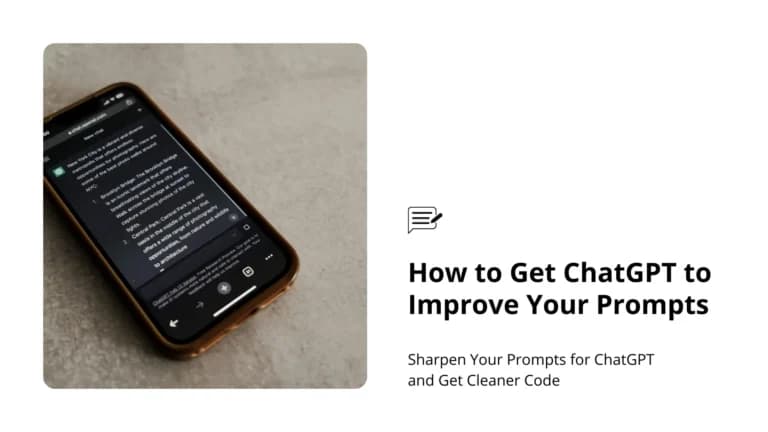
The other day I was trying to get ChatGPT to help me write a quick utility script.
Something simple, like:
“Write a Node.js script that reads a CSV file and outputs it as JSON.”
Sounds clear enough, right? But the output I got was messy, missing error handling, no comments, and not very readable.
Totally my fault. Not ChatGPT’s.
That’s when it clicked (again): the quality of what you get depends almost entirely on how clearly you ask for it.
Learning to ask better isn’t just about making AI work harder. It’s about thinking more clearly yourself.
Here’s how you can get ChatGPT to help you sharpen your prompts, and why it’s absolutely worth doing.
Why Prompts Matter More Than You Think
You can’t just toss a half-baked question into ChatGPT and expect clean, production-ready code.
AI isn’t magic. It’s a pattern machine. If your input is vague, confusing, or trying to cover too much at once, the output’s going to be just as messy.
A good prompt gives the model:
- Clear instructions
- Context about what you want
- Hints about tone, structure, style, and expectations
If you get that part right, you’ll spend way less time fixing bad AI output.
What “Improving a Prompt” Actually Means
It’s not about fancy language or writing paragraphs.
It’s about making your request:
- Clear (What exactly do you want?)
- Specific (What should it focus on?)
- Structured (Any formatting, coding conventions, etc.)
You’re basically telling the AI what “good” looks like before it starts.
Step 1: Start With Your Rough Draft Prompt
First rule: don’t overthink your first version.
Just get the idea out.
Something like:
“Write a Node.js script to convert CSV to JSON.”
It’s basic. It’s rough. That’s fine. The point is to have something to iterate on.
Step 2: Ask ChatGPT to Review Your Prompt
Now hand it back to ChatGPT and say:
“I want to improve this prompt to get better code quality. Here’s my prompt: [insert rough prompt]. Can you suggest ways to make it sharper, clearer, or more detailed?”
Frame it like you’re asking a senior dev for advice.
Step 3: Let ChatGPT Suggest Improvements
ChatGPT will usually give back variations like:
- Adding expectations (error handling, readable code, comments)
- Specifying input/output formats
- Suggesting test cases
You’ll quickly see how it reframes your idea into something much more actionable.
Step 4: Pick or Tweak the Best Suggestions
Don’t just grab whatever it gives you.
Use your brain. Choose the suggestions that make sense, ignore the ones that overcomplicate it, and tweak the rest.
Prompting is iterative, just like coding.
Step 5: Test the New Prompt
Take your improved prompt and run it.
You’ll usually notice:
- Cleaner, more robust code
- Better explanations
- Less need for endless \”small fix\” follow-ups
It’s a little thing that can save you a ton of time later.
Bonus Tricks: How to Boost Your Prompts Even More
Here’s how to give your prompts a serious upgrade:
1. Set the Output Format
\”Give me the code first, then a short explanation below.\”
2. Define the Code Style
\”Use modern ES6+ syntax.\”
\”Comment each function clearly.\”
3. Specify the Audience
\”Beginner-friendly code\” vs \”production-ready code.\”
4. Add Constraints
\”Keep it under 50 lines.\”
\”Don’t use third-party libraries.\”
5. Ask for Edge Cases
\”Add a sample CSV input and expected JSON output.\”
\”Handle empty rows gracefully.\”
These tiny details make a massive difference in the result.
Common Mistakes most of us do
- Overloading the prompt: Trying to get too much done at once. Split it.
- Being too vague: \”Make a script\” isn’t enough. Specify what the script needs to do, how it should behave.
- Not setting expectations: If you don’t say you want clean code with comments, don’t be surprised when you don’t get it.
Keep your prompts sharp. Keep them realistic.
Final Thought
Getting better at prompting isn’t just about getting better AI outputs.
It trains your brain to structure problems clearly, communicate expectations better, and think ahead.
Which, honestly, makes you a better developer, a better writer, and a better collaborator.
Start rough. Improve a little. Test it. Learn from it.
That’s all prompting really is.
